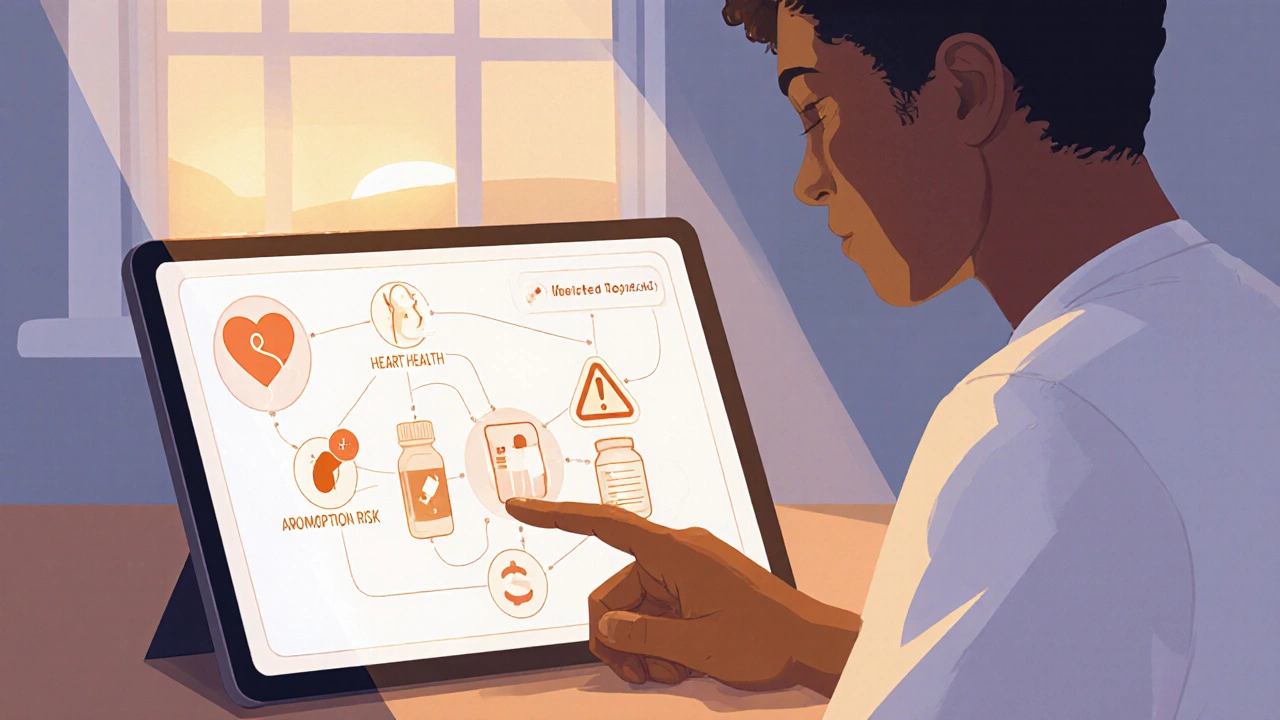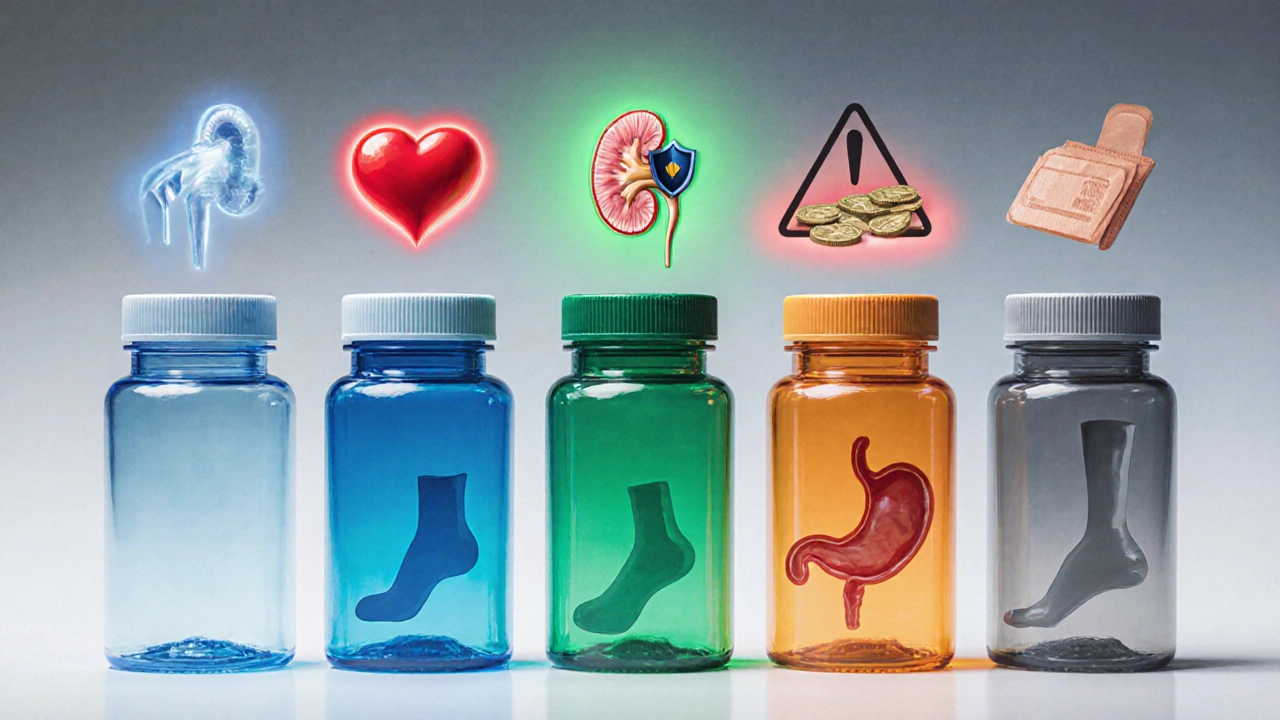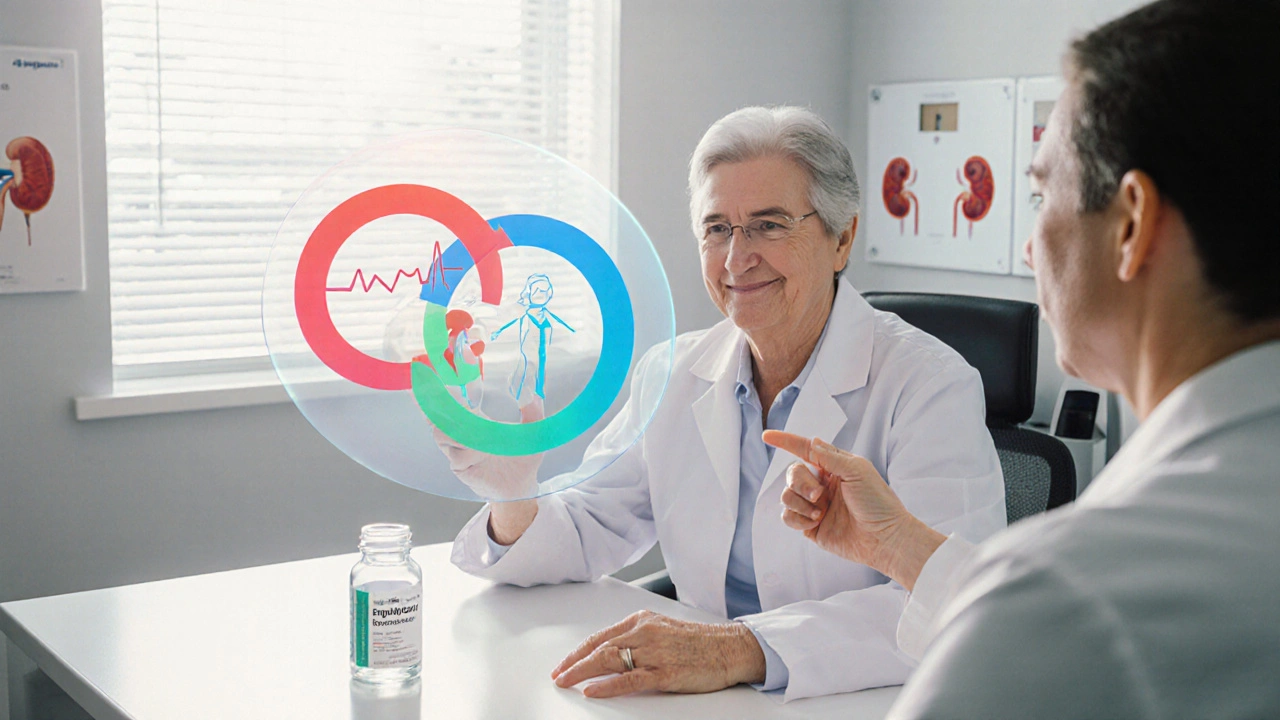Empagliflozin vs Other Diabetes Drugs: In‑Depth Comparison
 Oct, 4 2025
Oct, 4 2025
Empagliflozin vs Other Diabetes Drugs: Decision Guide
Recommended Medication Options
| Drug | Cardiovascular Benefit | Kidney Protection | Side Effects | Cost Consideration |
|---|
- This tool provides general guidance only. Always consult with your healthcare provider for personalized medical advice.
- Medication selection depends on individual health conditions, insurance coverage, and personal preferences.
Key Takeaways
- Empagliflozin is an SGLT2 inhibitor proven to cut cardiovascular death in high‑risk type2 diabetes patients.
- Its main rivals - dapagliflozin, canagliflozin and ertugliflozin - share the glucose‑lowering mechanism but differ in cardiovascular outcomes, kidney benefits, and side‑effect profiles.
- Metformin remains the first‑line therapy; combine it with an SGLT2 inhibitor when additional HbA1c reduction or organ protection is needed.
- Choosing the right drug hinges on three factors: heart/kidney risk, tolerance for genital infections, and insurance cost‑sharing.
- Look out for drug‑specific warnings - canagliflozin has a higher amputation signal, ertugliflozin may cause more urinary‐tract infections.
When you or a loved one are told to start a new diabetes pill, the list of brand names can feel endless. Empagliflozin often pops up because of its strong heart‑health data, but is it really the best fit? This guide walks through the science, the numbers, and the real‑world pros and cons of Empagliflozin and its closest competitors, so you can decide which medication aligns with your health goals and budget.
What Is Empagliflozin?
Empagliflozin is a prescription medicine classified as a selective sodium‑glucose co‑transporter‑2 (SGLT2) inhibitor. It works by blocking the kidney’s ability to re‑absorb glucose, allowing excess sugar to exit the body in urine. Approved by the FDA in 2014, Empagliflozin is marketed under the brand name Jardiance and is indicated for adults with type2 diabetes, heart failure, and chronic kidney disease.
How SGLT2 Inhibitors Like Empagliflozin Lower Blood Sugar
The kidneys filter about 180g of glucose each day. SGLT2 proteins normally pull most of that glucose back into the bloodstream. By inhibiting this transporter, Empagliflozin causes a steady loss of 40‑80g of glucose daily, translating to a 0.5‑1.0% drop in HbA1c after 12weeks. The side effect? More frequent urination and a modest calorie loss (≈200kcal/day), which can aid weight reduction.
Major Alternatives to Empagliflozin
All listed drugs belong to the SGLT2 class, except where noted. Below each drug’s first mention includes microdata markup for easy knowledge‑graph extraction.
Dapagliflozin (brand Farxiga) received FDA approval in 2014 and shares the same glucose‑excretion mechanism. Its standout trial, DECLARE‑TIMI 58, showed solid heart‑failure benefit but a less pronounced reduction in major cardiovascular events compared with Empagliflozin.
Canagliflozin (brand Invokana) entered the market in 2013. It carries an additional warning for increased risk of lower‑extremity amputation, based on the CANVAS program findings.
Ertugliflozin (brand Steglatro) was approved in 2017. Clinical data (VERTIS CV) showed non‑inferior cardiovascular safety but did not demonstrate superiority for reducing cardiovascular death.
Metformin (biguanide class) has been the cornerstone of type2 diabetes management since the 1950s. Though it works via hepatic glucose production suppression rather than renal excretion, it is often combined with an SGLT2 inhibitor for additive HbA1c lowering.

Side‑by‑Side Comparison
| Drug | Brand | FDA Approval Year | Primary Indication | Cardiovascular Benefit | Kidney Protection | Common Side Effects |
|---|---|---|---|---|---|---|
| Empagliflozin | Jardiance | 2014 | Type2 diabetes, HFrEF, CKD | ↓Cardiovascular death (EMPA‑REG OUTCOME) | ↓eGFR decline, ↓albuminuria | Genital mycotic infection, volume depletion |
| Dapagliflozin | Farxiga | 2014 | Type2 diabetes, HFrEF, CKD | ↓HF hospitalization (DECLARE‑TIMI 58) | Similar renal slowing, modest albuminuria reduction | Genital infection, urinary‑tract infection |
| Canagliflozin | Invokana | 2013 | Type2 diabetes, HFrEF, CKD | ↓MACE (CANVAS) | Renal benefits comparable | Amputation risk, genital infection |
| Ertugliflozin | Steglatro | 2017 | Type2 diabetes | Non‑inferior CV safety (VERTIS CV) | Limited renal data | UTI, genital infection, hypotension |
| Metformin | Glucophage (various generics) | 1995 (US) | First‑line for type2 diabetes | No proven CV mortality benefit | Potential modest renal protection | Gastro‑intestinal upset, B12 deficiency |
Decision‑Making Checklist
Before you ask your doctor for a prescription, run through these practical points. Tick the boxes that apply to your situation.
- Cardiovascular risk: If you have established ASCVD or heart failure with reduced ejection fraction, Empagliflozin or Dapagliflozin are top picks.
- Kidney function: For eGFR≥30mL/min/1.73m², all SGLT2 inhibitors work, but Empagliflozin shows the strongest albuminuria reduction.
- Amputation concern: Avoid Canagliflozin if you have peripheral artery disease or a history of foot ulcers.
- Genital infection tolerance: Women and uncircumcised men often report mycotic infections; proper hygiene and occasional antifungal prophylaxis can help.
- Insurance coverage & cost: Metformin is cheapest; SGLT2 inhibitors vary widely. Check your formulary for tier‑3 vs tier‑4 placement.
When Empagliflozin Is the Right Choice
If you have any of the following, Empagliflozin usually edges out the competition:
- Recent myocardial infarction or established coronary artery disease.
- Heart failure with EF≤40% (reduced ejection fraction) or preserved EF with high natriuretic peptides.
- Stage3 chronic kidney disease (eGFR 30‑59) where you also want to slow further decline.
- Desire for modest weight loss (≈2‑3kg) without injectable therapy.
Clinical guidelines (ADA 2025) now list Empagliflozin as a ClassI recommendation for patients with ASCVD, placing it ahead of other SGLT2 inhibitors for mortality benefit.
When Another Drug Might Fit Better
Each alternative shines under specific circumstances:
- Dapagliflozin: Ideal if your primary goal is reducing heart‑failure hospitalizations and you have a lower baseline CV death risk.
- Canagliflozin: May be chosen for its stronger impact on major adverse cardiovascular events (MACE) if you have no peripheral vascular disease.
- Ertugliflozin: Useful when a simplified once‑daily dosing schedule is needed and you have limited insurance coverage for Jardiance or Farxiga.
- Metformin: Remains first‑line for newly diagnosed patients without significant CV or renal disease; cheap and well‑tolerated.
Practical Tips & Common Pitfalls
- Stay hydrated: SGLT2 inhibitors increase urinary glucose loss, which can lead to volume depletion, especially in older adults.
- Monitor eGFR: If kidney function drops below 30mL/min/1.73m², discontinue the SGLT2 blocker and switch to an alternative glucose‑lowering strategy.
- Watch for ketoacidosis: Though rare, euglycemic diabetic ketoacidosis can occur. Educate yourself on symptoms (nausea, abdominal pain, rapid breathing) and seek care promptly.
- Address genital infections early: Over‑the‑counter antifungal creams work for most cases; discuss prophylactic options if infections recur.
- Insurance formularies change yearly: Re‑verify coverage during open enrollment; a slight switch in tier can dramatically affect out‑of‑pocket cost.

Frequently Asked Questions
Can I take Empagliflozin with Metformin?
Yes. Combining an SGLT2 inhibitor with Metformin is a common strategy. Metformin tackles hepatic glucose production, while Empagliflozin increases urinary glucose excretion, giving an additive HbA1c drop of about 0.7‑1.0%.
Does Empagliflozin cause weight loss?
On average, patients lose 2‑3kg over a year thanks to calorie loss in the urine. The effect is modest compared with GLP‑1 agonists, but it’s a nice bonus for many users.
What should I do if I develop a yeast infection?
First, keep the area clean and dry. Over‑the‑counter antifungal creams (clotrimazole or miconazole) usually clear the infection within a week. If it recurs, ask your doctor about a short course of oral fluconazole.
Is Empagliflozin safe for people with moderate kidney disease?
Yes. Clinical trials included patients with eGFR down to 30mL/min/1.73m², showing continued glucose‑lowering and renal‑protective effects. Below that threshold, the drug loses efficacy and is usually stopped.
How does Empagliflozin compare cost‑wise to Dapagliflozin?
Both are brand‑only (no generic) in the U.S., and prices hover around $400‑$450 per month before insurance. Some plans place Jardiance on a Tier3 formulary, while Farxiga lands on Tier4, making the out‑of‑pocket cost slightly lower for Empagliflozin in those plans.
Armed with this side‑by‑side view, you can have a focused conversation with your healthcare provider about which drug fits your heart, kidney, and lifestyle needs best.

Tim Giles
October 4, 2025 AT 04:25Empagliflozin represents a notable advancement in the pharmacologic management of type‑2 diabetes, particularly for patients with concomitant cardiovascular disease. Its mechanism of action, involving selective inhibition of the sodium‑glucose co‑transporter‑2 in the proximal renal tubule, facilitates urinary glucose excretion, thereby reducing plasma glucose concentrations. Beyond glycemic control, the EMPA‑REG OUTCOME trial demonstrated a statistically significant reduction in cardiovascular mortality, a finding that distinguishes it from many other agents within its class. Moreover, secondary analyses have revealed favorable effects on renal endpoints, including attenuation of eGFR decline and diminution of albuminuria progression. The drug’s safety profile is generally acceptable, with genital mycotic infections and modest volume depletion constituting the most frequently reported adverse events. In patients with preserved renal function-specifically an eGFR of 60 mL/min/1.73 m² or greater-the antihyperglycemic efficacy is robust, while even those with moderate impairment retain clinical benefit. Comparative data suggest that while dapagliflozin shares similar renal outcomes, its impact on overall cardiovascular death is less pronounced. Canagliflozin, while effective, carries an additional warning regarding lower‑extremity amputation, necessitating cautious use in individuals with peripheral arterial disease. Ertugliflozin offers a modest cost advantage in certain formularies, yet its renal data remain comparatively limited. Metformin continues to serve as the foundational therapy for most newly diagnosed patients, and its combination with an SGLT2 inhibitor frequently yields synergistic HbA1c reduction. When evaluating therapeutic options, clinicians must weigh individual patient characteristics, such as baseline cardiovascular risk, renal function, propensity for genital infections, and insurance coverage constraints. It is also prudent to monitor for rare but serious events, including euglycemic diabetic ketoacidosis, particularly in the setting of acute illness or reduced caloric intake. Hydration status warrants attention, as the osmotic diuresis induced by SGLT2 inhibition can predispose susceptible patients to volume depletion. Patient education regarding genital hygiene and early recognition of infection symptoms can mitigate one of the most common adverse events. Ultimately, the decision matrix for selecting an SGLT2 inhibitor should be individualized, integrating evidence‑based outcomes with patient preferences and socioeconomic considerations. The emerging consensus from contemporary guidelines places empagliflozin as a Class I recommendation for individuals with established atherosclerotic cardiovascular disease, underscoring its preeminence among contemporaries. Continuous appraisal of evolving trial data will further refine its positioning within the therapeutic armamentarium.
Peter Jones
October 12, 2025 AT 17:59Reading through the comparison, it’s clear that each SGLT2 inhibitor brings a distinct blend of benefits and trade‑offs, which makes shared decision‑making with patients all the more important. Empagliflozin’s strong cardiovascular mortality data tip the scales for high‑risk individuals, whereas dapagliflozin may be preferable when heart‑failure hospitalizations are the primary concern. Cost considerations often dictate real‑world choices, so checking formulary tiers before prescribing can prevent unexpected out‑of‑pocket expenses. Combining these agents with metformin remains a solid strategy for many, providing additive glucose‑lowering while keeping side‑effects manageable. Ultimately, the best match aligns clinical evidence with the patient’s personal health goals and financial realities.
Gerard Parker
October 21, 2025 AT 07:32From an expert standpoint, the hierarchy of evidence places empagliflozin at the top for reducing cardiovascular death, a claim backed by robust phase III data. When you factor in renal protection, dapagliflozin trails only slightly, but its lack of mortality benefit should not be overlooked in high‑risk cohorts. Canagliflozin’s amputation signal is a real red flag; I would avoid it in any patient with peripheral arterial disease without a compelling reason. Ertugliflozin’s lower price point is attractive, yet the paucity of long‑term renal outcomes makes me hesitant to recommend it as a first‑line SGLT2. In practice, I pair metformin with empagliflozin for most patients unless cost or contraindications force an alternative.
Thomas Burke
October 29, 2025 AT 21:05Got the gist of the guide
Empagliflozin rocks for heart health
Dapa is solid for HF stays
Watch your kidneys stay hydrated
Debbie Frapp
November 7, 2025 AT 10:39The article does a great job summarizing the nuances between each SGLT2 inhibitor, and I appreciate the clear tables that break down cardiovascular and renal outcomes. It’s especially helpful to see the side‑effect profiles laid out side by side, which aids in patient counseling. One point that stands out is the emphasis on individualized therapy based on risk stratification rather than a one‑size‑fits‑all approach. The inclusion of cost considerations also reflects real‑world prescribing realities that are often omitted in clinical trial reports. Overall, this guide provides a solid foundation for clinicians and patients alike to have an informed discussion.
Michelle Abbott
November 16, 2025 AT 00:12While the piece touts empagliflozin’s superiority, it glosses over the pharmacokinetic variability that can impact trough concentrations in renally compromised patients. The omission of a detailed discussion on SGLT2 transporter isoform selectivity feels like a shallow overview rather than a deep dive. Moreover, the cost analysis is superficial, neglecting the nuances of pharmacy benefit manager rebates that drive actual patient out‑of‑pocket spend. In short, the guide could benefit from a more rigorous, data‑driven exposition.
Heather Jackson
November 24, 2025 AT 13:45Wow, this guide really hits the nail on the head-empagliflozin is like the superhero of diabetes meds, swooping in to save hearts and kidneys! But canagliflozin? That's more like the risky sidekick that might trip you up with amputations if you're not careful. The cost stuff is a real drama too, especially when insurance plays hard to get. All in all, it's a solid read, even if some parts feel a lil' rushed.
Akshay Pure
December 3, 2025 AT 03:19One must commend the effort to collate such data, yet the narrative suffers from a paucity of critical appraisal, rendering it a mere compendium rather than a scholarly treatise. The author’s reliance on surface‑level statistics betrays a reluctance to engage with the underlying mechanistic heterogeneity among SGLT2 inhibitors. Furthermore, the omission of head‑to‑head meta‑analyses deprives the discerning clinician of the granular insight requisite for nuanced prescribing. While the lay‑reader may find the piece approachable, the connoisseur will inevitably deem it insufficiently rigorous.